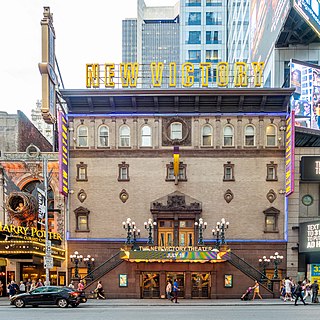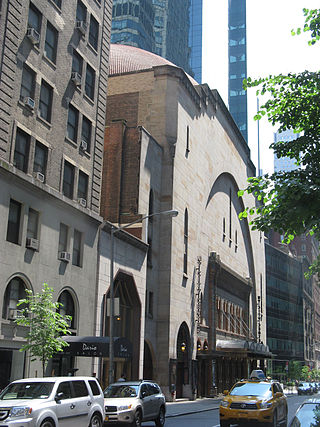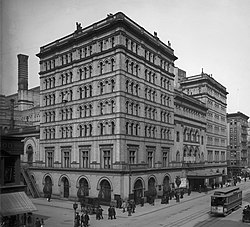
The Metropolitan Opera is an American opera company based in New York City, currently resident at the Metropolitan Opera House at Lincoln Center, situated on the Upper West Side of Manhattan. The company is operated by the non-profit Metropolitan Opera Association, with Peter Gelb as the general manager. The company's music director has been Yannick Nézet-Séguin since 2018.

The Majestic Theatre is a Broadway theater at 245 West 44th Street in the Theater District of Midtown Manhattan in New York City. Opened in 1927, the theater was designed by Herbert J. Krapp in a Spanish style and was built for real-estate developer Irwin S. Chanin. It has 1,681 seats across two levels and is operated by The Shubert Organization. Both the facade and interior are New York City landmarks.

The August Wilson Theatre is a Broadway theater at 245 West 52nd Street in the Theater District of Midtown Manhattan in New York City. Opened in 1925, the theater was designed by C. Howard Crane and Kenneth Franzheim and was built for the Theatre Guild. It is named for Pulitzer Prize-winning playwright August Wilson (1945–2005). The August Wilson has approximately 1,225 seats across two levels and is operated by Jujamcyn Theaters. The facade is a New York City designated landmark.

The Al Hirschfeld Theatre, originally the Martin Beck Theatre, is a Broadway theater at 302 West 45th Street in the Theater District of Midtown Manhattan in New York City. Opened in 1924, it was designed by G. Albert Lansburgh in a Moorish and Byzantine style and was constructed for vaudevillian Martin Beck. It has 1,404 seats across two levels and is operated by Jujamcyn Theaters. Both the facade and the interior are New York City landmarks.

The Shubert Theatre is a Broadway theater at 225 West 44th Street in the Theater District of Midtown Manhattan in New York City. Opened in 1913, the theater was designed by Henry Beaumont Herts in the Italian Renaissance style and was built for the Shubert brothers. Lee and J. J. Shubert had named the theater in memory of their brother Sam S. Shubert, who died in an accident several years before the theater's opening. It has 1,502 seats across three levels and is operated by The Shubert Organization. The facade and interior are New York City landmarks.

The Academy of Music was a New York City opera house, located on the northeast corner of East 14th Street and Irving Place in Manhattan. The 4,000-seat hall opened on October 2, 1854. The review in The New York Times declared it to be an acoustical "triumph", but "In every other aspect ... a decided failure," complaining about the architecture, interior design and the closeness of the seating; although a follow-up several days later relented a bit, saying that the theater "looked more cheerful, and in every way more effective" than it had on opening night.

The Broadway Theatre is a Broadway theater at 1681 Broadway in the Theater District of Midtown Manhattan in New York City. Opened in 1924, the theater was designed by Eugene De Rosa for Benjamin S. Moss, who originally operated the venue as a movie theater. It has approximately 1,763 seats across two levels and is operated by The Shubert Organization. The Broadway Theatre is one of the few Broadway theaters that is physically on Broadway.

The Vivian Beaumont Theater is a Broadway theater in the Lincoln Center complex at 150 West 65th Street on the Upper West Side of Manhattan in New York City. Operated by the nonprofit Lincoln Center Theater (LCT), the Beaumont is the only Broadway theater outside the Theater District near Times Square. Named after heiress and actress Vivian Beaumont Allen, the theater was one of the last structures designed by modernist architect Eero Saarinen. The theater shares a building with the New York Public Library for the Performing Arts and contains two off-Broadway venues, the Mitzi E. Newhouse Theater and the Claire Tow Theater.

The Gerald Schoenfeld Theatre, formerly the Plymouth Theatre, is a Broadway theater at 236 West 45th Street in the Theater District of Midtown Manhattan in New York City. Opened in 1917, the theater was designed by Herbert J. Krapp and was built for the Shubert brothers. The Schoenfeld Theatre is named for Gerald Schoenfeld, longtime president of the Shubert Organization, which operates the theater. It has 1,079 seats across two levels. Both the facade and the auditorium interior are New York City landmarks.

The Nederlander Theatre is a Broadway theater at 208 West 41st Street in the Theater District of Midtown Manhattan in New York City. Opened in 1921, it was designed by William Neil Smith for theatrical operator Walter C. Jordan. It has around 1,235 seats across two levels and is operated by the Nederlander Organization. Since 1980, it has been named for American theater impresario David Tobias Nederlander, father of theatrical producer James M. Nederlander. It is the southernmost Broadway theater in the Theater District.

The John Golden Theatre, formerly the Theatre Masque and Masque Theater, is a Broadway theater at 252 West 45th Street in the Theater District of Midtown Manhattan in New York City. Opened in 1927, the Golden Theatre was designed by Herbert J. Krapp in a Spanish style and was built for real-estate developer Irwin S. Chanin. It has 800 seats across two levels and is operated by the Shubert Organization. Both the facade and the auditorium interior are New York City landmarks.

The Lyric Theatre is a Broadway theater at 214 West 43rd Street in the Theater District of Midtown Manhattan in New York City. Opened in 1998, the theater was designed by Richard Lewis Blinder of Beyer Blinder Belle, in collaboration with Peter Kofman, for Garth Drabinsky and his company Livent. The Lyric Theatre was built using parts of two former theaters on the site: the Apollo Theatre, built in 1920 to a design by Eugene De Rosa, and the old Lyric Theatre, built in 1903 to a design by Victor Hugo Koehler. The theater contains 1,622 seats across three levels and is operated by Ambassador Theatre Group (ATG). The theater building is owned by the city and state governments of New York and was developed by New 42nd Street.

The Broadhurst Theatre is a Broadway theater at 235 West 44th Street in the Theater District of Midtown Manhattan in New York City. Opened in 1917, the theater was designed by Herbert J. Krapp and was built for the Shubert brothers. The Broadhurst Theatre is named for British-American theatrical producer George Broadhurst, who leased the theater before its opening. It has 1,218 seats across two levels and is operated by The Shubert Organization. Both the facade and the auditorium interior are New York City landmarks.

The Lyceum Theatre is a Broadway theater at 149 West 45th Street, between Seventh Avenue and Sixth Avenue, in the Theater District of Midtown Manhattan in New York City. Opened in 1903, the Lyceum Theatre is one of the oldest surviving Broadway venues, as well as the oldest continuously operating legitimate theater in New York City. The theater was designed by Herts & Tallant in the Beaux-Arts style and was built for impresario Daniel Frohman. It has 922 seats across three levels and is operated by The Shubert Organization. The facade became a New York City designated landmark in 1974, and the lobby and auditorium interiors were similarly designated in 1987.

The New Victory Theater is a theater at 209 West 42nd Street in the Theater District of Midtown Manhattan in New York City, near Times Square. Built in 1900 as the Republic Theatre, it was designed by Albert Westover and developed by Oscar Hammerstein I as a Broadway theater. The theater has been known by several names over the years, including the Belasco Theatre, Minsky's Burlesque, and the Victory Theatre. The theater is owned by the city and state governments of New York and leased to nonprofit New 42, which has operated the venue as a children's theater since 1995. The New Victory presents theater shows, dance shows, puppet shows, and other types of performance art shows from all around the world.

New York City's Theater District, sometimes spelled Theatre District and officially zoned as the "Theater Subdistrict", is an area and neighborhood in Midtown Manhattan where most Broadway theaters are located, in addition to other theaters, movie theaters, restaurants, hotels, and other places of entertainment. It is bounded by West 40th Street on the south, West 54th Street on the north, Sixth Avenue on the east and Eighth Avenue on the west, and includes Times Square. The Great White Way is the name given to the section of Broadway which runs through the Theater District.

Pike's Opera House, later renamed the Grand Opera House, was a theater in New York City on the northwest corner of 8th Avenue and 23rd Street, in the Chelsea neighborhood of Manhattan. It was constructed in 1868, at a cost of a million dollars, for distiller and entrepreneur Samuel N. Pike (1822–1872) of Cincinnati. The building survived in altered form until 1960 as an RKO movie theater, after which it was replaced by part of Penn South, an urban renewal housing development.

The Metropolitan Opera House is an opera house located on Broadway at Lincoln Square on the Upper West Side of Manhattan in New York City. Part of Lincoln Center, the theater was designed by Wallace K. Harrison. It opened in 1966, replacing the original 1883 Metropolitan Opera House at Broadway and 39th Street. With a seating capacity of approximately 3,850, the house is the largest repertory opera house in the world. Home to the Metropolitan Opera Company, the facility also hosts the American Ballet Theatre in the summer months.

New York City Center is a performing arts center at 131 West 55th Street between Sixth and Seventh Avenues in the Midtown Manhattan neighborhood of New York City. Developed by the Shriners between 1922 and 1924 as a Masonic meeting house, it has operated as a performing arts complex owned by the government of New York City. City Center is a performing home for several major dance companies as well as the Manhattan Theatre Club (MTC), and it hosts the Encores! musical theater series and the Fall for Dance Festival annually.





















